Tracking Wealth Through the AI Lens
Tracking Wealth Through the AI Lens
Netflix (NFLX) executed its 10-for-1 stock split recently, and the financial news is predictably buzzing. The stated reason? To make the stock more accessible to employees. Which is corporate-speak for: "Our stock price got too damn high." But does a lower price actually change the underlying value? Let's dive into the numbers and see if this split is a genuine opportunity or just financial engineering.
The move is straightforward enough. Shareholders of record received nine additional shares for every one they held. This theoretically brings the share price down to a more palatable level – around $111, based on pre-split closing prices, rather than the intimidating $1,100+ range. It's like exchanging a ten-dollar bill for ten singles, the total value remains the same. But psychology plays a role here, and that's where things get interesting.
One analyst, Daniel Sparks, is quoted as deeming Netflix's forward Price-to-Earnings (P/E) ratio of 35x as "reasonable (and even attractive)," given Netflix's market leadership and growth prospects. But let's unpack that "reasonable." A P/E of 35x means investors are paying $35 for every dollar of Netflix's earnings. Is that truly attractive in a market where other tech giants have P/E ratios hovering closer to 25x? (Apple, for instance, often trades in that range). The market clearly has priced in substantial future growth for Netflix.
Netflix's Q3 earnings missed expectations, largely due to an expense related to a Brazilian tax dispute. Yet, analysts like Alicia Reese at Wedbush remain bullish, citing potential growth in global advertising. She even suggests that ad revenue will become Netflix's primary revenue driver by 2026. That's a bold prediction. How quickly can Netflix scale its ad business to offset any potential slowdown in subscriber growth? And what impact will increased advertising have on the user experience? These are critical questions that the bullish analysts seem to gloss over.

The core argument hinges on ad revenue. Netflix's foray into advertising is still nascent, and while it's showing promise, it's far from a guaranteed success. The company's operating margin is expected to jump from 27% to 29% this year, but a lot of that relies on the assumption that they can effectively monetize their user base through ads without alienating them. (This is the part of the report that I find genuinely puzzling; can they really thread this needle?)
Consider the competitive landscape. Netflix isn't just competing with other streaming services; they're now vying for ad dollars against Google, Meta, and Amazon – companies with far more sophisticated advertising infrastructure and troves of user data. Can Netflix truly compete in that arena? The data on ad revenue growth will be crucial in the coming quarters. As reported by Benzinga, the stock's performance is being closely watched to see if it can maintain its growth trajectory: What's Going On With Netflix Stock? - Netflix (NASDAQ:NFLX).
Looking at the technical indicators, the picture is equally unclear. Netflix is trading below both its 50-day and 200-day moving averages, suggesting a bearish short-term trend. The Relative Strength Index (RSI) sits at 43.01, indicating neutral territory. This is a fancy way of saying that the stock could go either way. Support is identified at $107.33, and resistance at $113.48. These numbers are just lines in the sand. They tell you where the stock might bounce or stall, but they offer no insight into the underlying fundamentals. What truly matters is whether Netflix can deliver on its growth promises.
Ultimately, the stock split is a cosmetic change. It makes the stock more accessible to retail investors and employees, which can create some short-term buzz and potentially drive up demand. But it doesn't alter the fundamental value of the company. Netflix's future hinges on its ability to grow its subscriber base, successfully monetize its advertising business, and maintain its competitive edge in the increasingly crowded streaming landscape. Without those elements, the split is just rearranging deck chairs.